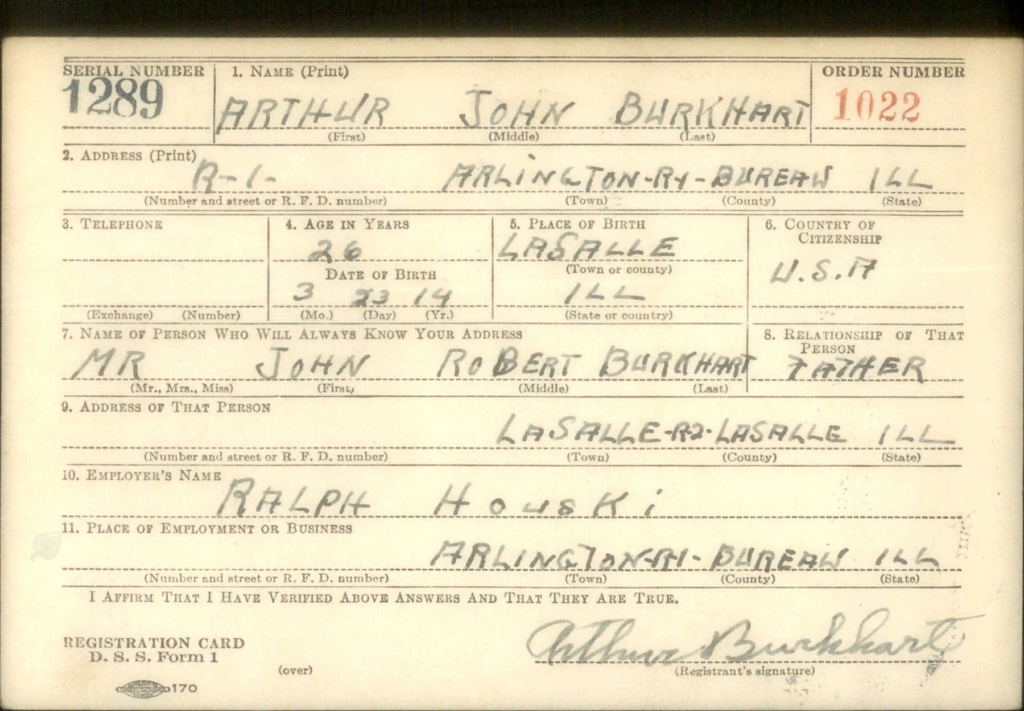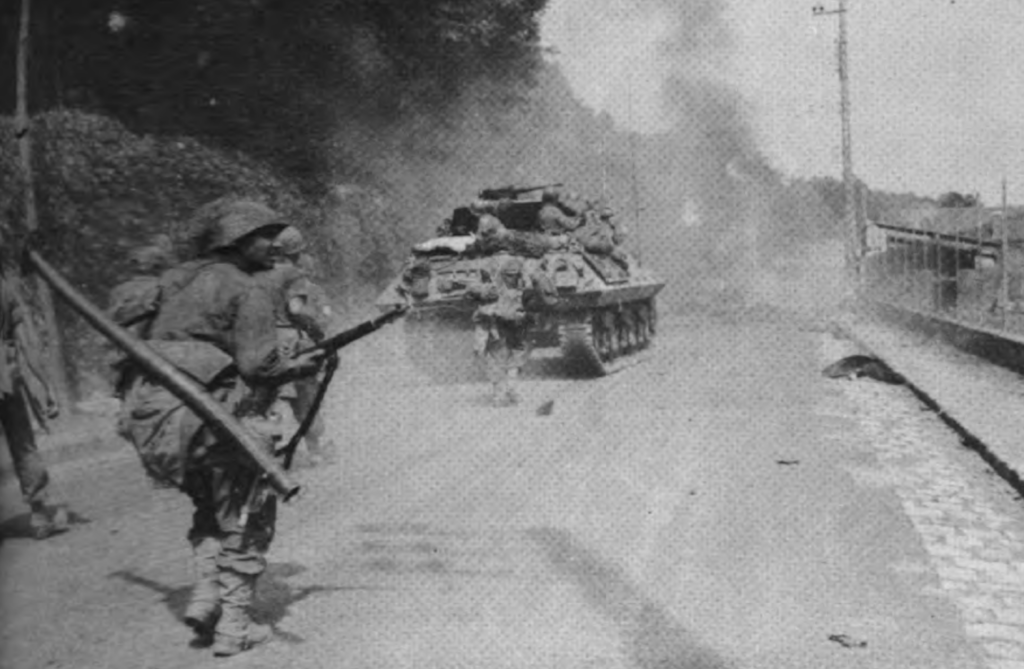Arthur John Burkhart was born March 23, 1914, in LaSalle county, Illinois, to John Robert and Bertha Offergeld Burkhart. Both John and Bertha had been raised on Chartres street in LaSalle, also known as Airport road, and only lived a little over a mile apart. They married on November 23, 1910, and throughout their marriage had a total of seven children of which Arthur was the second born.
Arthur’s grandparents on his father’s side were Robert and Sophie Meisenbach Burkhart. Robert was a farmer who had arrived in American from Germany about 1873. In addition to Arthur’s father, Robert and Sophia had two daughters, Anna and Margaret.
Arthur’s mother Bertha was the daughter of Matthew and Johanna Offergeld. Throughout much of Arthur’s childhood, his maternal grandfather, Matthew, worked as a packer at the Western Clock Company and lived at 1332 Chartres street in LaSalle with his wife and Bertha’s seven siblings. Like his paternal grandfather, Matthew Offergeld had left Germany to settle in the U.S.
Arthur spent most of his life also living on a farm in north LaSalle township near his grandparents. When Arthur was 10, his paternal grandmother, Sophia Burkhart passed away on July 24, 1924. About 11 years later, he lost two grandparents in one year: his maternal grandmother Johanna Offergeld on April 24, 1935, and his paternal grandfather Robert Burkhart on September 9, 1935. His last grandparent Matthew Offergeld died on November 19, 1938—three years after his wife.
Arthur attended school through the eighth grade and spent his time after that working on the family farm. On October 16, 1940, Arthur and his brother Raymond both registered for the draft. At age 26, Arthur was six feet and weighed 179 pounds with gray eyes and brown hair. Two years after registering, Arthur enlisted in the U.S. Army at Camp Grant in Illinois on January 16, 1942, at age 27. He was eventually assigned to the 10th Tank Battalion, 5th Armored Division and promoted to Staff Sergeant.

Arthur’s division trained at Pine Camp in New York. Because the 10th Tank Battalion was not designated until after Arthur enlisted, he may have started out in a different regiment that was rolled into the 10th. While still stateside, Arthur lost his father on Easter Sunday, April 9, 1944, due to a heart attack. It does not appear Arthur was able to take leave to attend the funeral, possibly because his division had received orders on February 23rd of that year to begin getting ready for deployment overseas.
The 5th Division arrived in Europe on August 26, 1944, under Patton’s Third Army. But soon after, they were transferred to the First Army. On August 29th the division was also placed in the V Corps along with the 4th and 28th Infantry Divisions. The next day, “the V Corps’ Fifth Armored passed over the river in Paris on 30 August.” They were on their way through France with the objective of reaching the Belgian border at Conde which they achieved the night of September 2nd.
Two days later the V Corp’s three divisions advanced towards Luxembourg. The 5th Armored headed towards Charleville-Mezieres north of Sedan reaching it that afternoon. Throughout their drive, they were challenged by a lack of gasoline. And on September 7, the V Corps was ordered to a halt due to this shortage. Two days later they were ordered to begin moving again this time towards Izel, St. Maries, Arlon and Guirsch to Mersch.
After crossing the Alzette River the Battalion moved onto Schrondweiler. By September 11th, the division spanned across the Luxembourg border, poised to storm the Siegfried Line—“the crescent of steel and concrete fortifications which supposedly made the Reich impregnable.” The 10th Battalion was sitting southwest of the German town of Wallendorf. Sometime that afternoon, other members of the 5th Division made the historic first crossing of U.S. troops into Nazi Germany. A part of the battalion climbed the steep terrain behind the town to empty the fortifications on the ridge. After the troops secured the enemy’s position, a fog descended on the valley below and remained until morning.

On September 14th, the 47th Infantry supported by the 10th Battalion crossed the Our River at Wallendorf. The next few days were spent trying to secure their position as Germany sent forces to oust the U.S. troops. The day of the 19th began shrouded by fog with German forces shelling the Battalion’s position. Throughout the day they were able to hold off the assault, but they were running low on ammo because the ammo trucks could not get through. Eventually they were ordered to leave Germany and return to Luxembourg, a move that was completed the morning of September 20th. Sometime that day during this Battle of the Wallendorf Corridor, Staff Sergeant Burkhart lost his life; he was 30 years old.
A niece later said, “Uncle Arty did not have to go into the war … but told everyone he was going over there to personally stop the war and get everyone home.” With that determination it is not surprising this young man was part of what became known as the “Victory” division and the operation that first entered Germany on the ground, returned the Prince of Luxembourg to his country, and stormed across the continent in record time.
As Arthur’s remains were never recovered, he is listed on the Tablets of the Missing in the Luxembourg American Cemetery in Hamm, Luxembourg. The U.S., World War II and Korean Conflict Veterans Interred Overseas database indicates he was awarded the Purple Heart. He would have also received a Combat Infantryman Badge and the following medals: Army Good Conduct Medal, American Campaign Medal, Europe/African/Middle Eastern Campaign Medal, and the World War II Victory Medal.
This story is part of the Stories Behind the Stars project (see www.storiesbehindthestars.org). This is a national effort of volunteers to write the stories of all 421,000+ of the US WWII fallen saved on Together We Served and Fold3. Can you help write these stories? These stories will be accessible via smartphone app at any war memorial or cemetery.
If you noticed anything erroneous in this profile or have additional information to contribute to it, please email feedback@storiesbehindthestars.org.
SBTSProject/Illinois/LaSalle
SBTS Historian: Pam Broviak
You can also access this story at the following sites:
Sources:
- 1900 U.S. Census, Robert Burkhart, Ancestry.
- 1910 U.S. Census, Matthew Offergeld, Ancestry.
- 1920 U.S. Census, John Burkhart, Ancestry.
- 1930 U.S. Census, John Burkhart, Ancestry.
- 1940 U.S. Census, John Burkhart, Ancestry.
- “U.S., City Directories, 1822-1995,” LaSalle, Illinois, 1924, Matthew Offergeld, Ancestry.
- “U.S., City Directories, 1822-1995,” LaSalle, Illinois, 1935, Arth J Burkhart, Ancestry
- “Illinois, U.S., Deaths and Stillbirths Index, 1916-1947,” Robert Burkhart, Sophia Burkhart, Matthew Offergeld, Johanna Offergeld, database, Ancestry.
- “U.S., World War I Draft Registration Cards, 1917–1918,” John Robert Burkhart, database with images, Ancestry.
- “U.S., World War II Draft Cards Young Men, 1940-1947,” Arthur John Burkhart, database with images, Ancestry.
- “U.S., World War II Army Enlistment Records, 1938-1946,” Arthur J. Burkhart, database, Ancestry.
- “U.S., World War II and Korean Conflict Veterans Interred Overseas,” Arthur J. Burkhart, database, Ancestry.
- “U.S., Headstone and Interment Records for U.S., Military Cemeteries on Foreign Soil, 1942-1949,” Arthur J. Burkhart, database, Ancestry.
- “Order of Battle of the U.S. Army – WWII – ETO, 5th Armored Division,” U.S. Army Center of Military History, website (https://history.army.mil/documents/eto-ob/5ad-eto.htm : accessed 17 April 2022).
- Vic Hillery, Vic; Emerson F. Hurley, Fifth Armored Division Association (U.S.), Paths of Armor: Normandy, Northern France, Ardennes, Alsace, Rhineland, Central Europe, (Love Enterprises, Atlanta, Ga.: 1950); ebook, Archive.org (https://archive.org/details/PathsOfArmor : accessed 18 April 2022).
- https://www.findagrave.com/memorial/55956735/arthur-j-burkhart